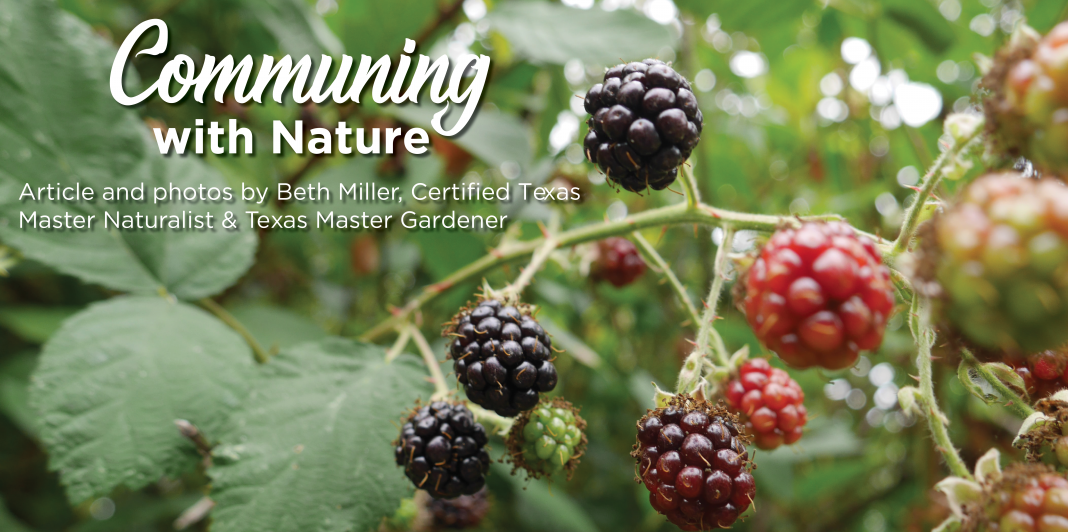Communing with Nature: Go Native. Better for You, Better for Bugs and Birds!
How would you like your garden beds to become nearly maintenance free, rich with pollinator insects, colorful year-round, and your bird watching bringing new visitors almost daily? It’s not as hard as you think, and it can look surprisingly planned and totally natural.
Several classes in the past two weeks reconfirmed my passion and commitment, as a Texas Master Gardener and Master Naturalist, to being an educator and advocate for the benefits to property owners of going native. Of course, I mean native plants. You make room by eliminating invasive plants like yaupon and Japanese honeysuckle to make room for American beautyberry, coral honeysuckle, wax myrtle, or Eastern redbud in the home landscape, providing numerous benefits to the environment.
Native plants have evolved to thrive through drought and dry, freeze and furnace, and provide food and habitat for local wildlife that we love to watch like birds, butterflies, and pollinators. Here are the primary ways going native benefits you and our piney wood ecosystem:
1. Support local biodiversity: Planting native plants helps support local biodiversity and provides a source of food and shelter for native wildlife from tiny microorganisms to a wide variety of insects and seek insect-loving birds.
2. Reduce water usage: Well-adapted to our crazy climate extremes, native plants generally need less water and maintenance. You can just sit and enjoy what you’ve created.
3. Improve soil health: With deep root systems, native plants help improve soil health and reduce erosion. And let the leaves just lay where they fall and decompose to become food for the soil. There’s nothing richer than leaf mold from a forest floor.
4. Reduce pesticide use: Less need for chemicals because natives are well adapted to local pests and diseases.
Here are some more native flowering plants to try: crimson clover (Trifolium incarnatum), black-eyed Susan (Rudbeckia hirta), cardinal flower (Lobelia cardinalis), or Possumhaw Holly (Ilex decidua).
Now that you’ve reduced chemical use and introduced plant life native to the region, the next big benefit is the increase you’ll see in beneficial insects moving into the area.
1. Ladybugs – Not to be confused with the swarming Japanese or harlequin beetles, feed on aphids, scale insects, and other pests that can damage crops.
2. Praying mantises – These incredibly interesting and voracious predators feed on a wide variety of insects, including flies, moths, and grasshoppers that annoy us and eat our good plants.
3. Lacewings – Though very small, this insect feeds on a variety of pests, including aphids, mites, and caterpillars, and yes, they can munch on butterfly larva.
4. Parasitic wasps – This body snatcher lays their eggs inside the bodies of other insects, and the larvae eat their way out, controlling populations of tomato horned worms and aphids.
5. Bees – Our super pollinators need all the help they can get, and with a rich, native environment you begin to see native bees show up to play their role in the reproduction of many plants and even crops.
6. Ground beetles – These predators, in a variety of shapes and sizes, feed on insects we can do without, like slugs and snails.
Overall, these insects and many others help to maintain the balance of East Texas ecosystems and can be valuable allies for farmers and gardeners in controlling pests and promoting healthy plant growth. And, with more good insects getting fat eating the bad ones, you’re sure to see more of the migratory bird visitors as they fly over, coming for native seeds, berries, and a juicy beetle or worm.
Learn more about the birds in East Texas by joining a chapter of the Texas Master Naturalist or Texas Master Gardeners. To find a chapter close to you, or to read about the state programs, visit txmn.org or txmg.org. Volunteer and get involved!

















